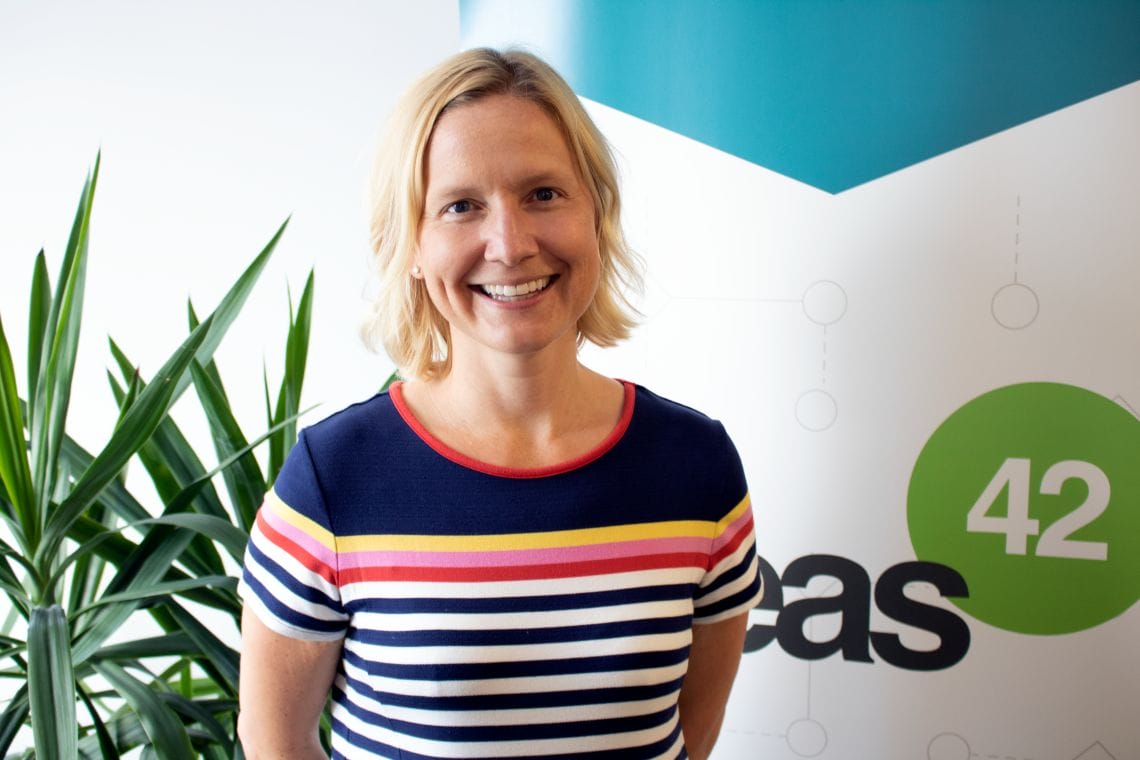With the ideas42 Seminar Series, we invite leading scholars to share their insights and what inspires their exploration into human behavior.
Our New York office was pleased to host Emily Balcetis, an Associate Professor of Psychology at New York University. Emily is interested in the conscious and nonconscious ways people orient to the world. She focuses on how people’s motivations, emotions, needs, and goals impact the basic ways people perceive, interpret, and ultimately react to information around them. She has a Ph.D in social psychology from Cornell University. After giving a talk to the ideas42 team, Emily was kind enough to share some of her thoughts on behavioral science:
What drew you to behavioral science?
Behavioral science offers opportunities to combine intrigue, creativity, and scientific rigor to really know something about why people do what they do. It’s like getting to be Sherlock Holmes without having to wear the hat, and I’ve always loved solving a good mystery.
What would you say is one of the most surprising discoveries about human behavior?
One of the most surprising discoveries about human behavior is how malleable it is. The situations we find ourselves in or construct for ourselves have a profound ability to change what we do and what we think. And there’s power in this. If we are influenced by who we are around and what space we find ourselves in, that’s a source of control for us. We can choose those situations and find ourselves nudged in ways that might better fit the types of people we want to be or become.
In your breadth of work, tell us about one of your favorite projects related to driving behavior change.
My team found out that we can teach people to literally look at their neighborhoods differently—to narrow their focus onto things, locations, or people that catch their eye—and that fosters better health. In particular, we found that a narrow focus of visual attention when you’re exercising helps you to exercise more often, move faster, and experience less physical pain even though nothing about exercise is actually any different. We can teach people this in five minutes and they apply it right then to better exercise. They hold onto that knowledge and use it in the weeks that follow too, creating lasting change. It works for people who are older or younger, and those who are heavier and struggling to work out. A slight change to how we perceive our surroundings has a big impact on our subjective experience of what it takes and our own capabilities, and that improves outcomes.
What have you learned in applying behavioral insights that has changed the way you work?
What we found works to improve exercise can be applied to most goals that we have to work now to reach in what might seem a distant future. It can be hard to sustain progress when the end state seems so remote or irrelevant to the challenges of today. I’ve applied this narrowed focus—and tweaked it reflect more cognitive rather than visual thoughts—and found that it can motivate me to get done today what I might otherwise procrastinate and put off until tomorrow. That actually reduces my stress and leads to better products.
How do you use behavioral insights in your daily life (or recommend that people use behavioral insights in their daily lives)?
Strategies that help people connect the distant future to the here and now can improve decision-making in many contexts. For instance, we often have a hard time setting aside a portion of today’s paycheck for retirement that might be 10, 20, or 30 years off. But by all accounts, we will be far better off even setting aside a small amount sooner rather than a larger amount later in our career. Finding ways to connect the current with the future makes this allocation easier. I had students on the brink of graduation send me headshots. I took those photos and morphed their images with famous older celebrities. I printed off those picture of my students “future selves.” The reactions were fantastic! Some women gasped and took quite a long while before they could take their next breath—shocked at what the future might literally look like for them. Others laughed. One man sat quietly for a few beats then said, “I think I look pretty good.” I asked them then whether they thought they might start setting aside some of their wages for retirement. While none in the group had done this to any degree yet, over 85% said they would now.
While finding ways to literally see what the future might look like for you may not be feasible—we don’t all have instant access to photo morphing software—there are ways to connect the future to the today to help us make decisions that could mean a bit of a sacrifice now for much greater rewards later. The key is figuring out how to see that far off end state as closer than we would otherwise.
In this case study, I also had my students take a few minutes to write about what they wanted to do with their lives when they were older. What did they do with their day? Where would they travel? Who would they spend their time with? Where did they live? Thinking through these details of their life in a few decades time connected them more with that “future self.” Bridging that mental, psychological distance was key to the changes in their decisions.



